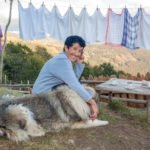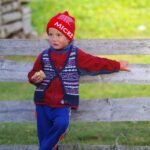- /
- What Are Katuns?
- /
- People
People
A woman in katun
A woman in katun is called ‘planinka’ which literally means mountain woman. She is the most important link in the life of the katun. Her role, as is the case with other family members as well, is closely related to cattle breeding, but she has an additional duty to care for the whole family. Every morning and every evening when cows and sheep return from the pastures, she has to milk them and then to make all kinds of dairy products that are made in katuns – cheese, kajmak (cream), kisjelo mlijeko (thick, home-made yogurt), jardum (a specialty made of sheep milk), urda (a type of skimmed cheese). This is serious work, and it repeats every day. In the meantime, she prepares meals for the family, cares for the garden as the family stays in katun long enough to plant a garden for basic food. Potatoes grown in katuns are widely known for their taste. The woman’s role is also to maintain hygiene in the hut and around it. In the season of mushrooms or blueberries, and after all her other work is done, she will often go to collect the mushrooms and blueberries, and medicinal and aromatic herbs. If any time remains, she will spin wool and knit socks, vests and sweaters for the family members. A life of a woman in katun is a hard one, a lot of hard and tiring work, and this is probably why fewer and fewer girls choose such life, and more and more young men in villages remain unmarried.
A man in katun
The man in the katun usually deals with all the difficult tasks – collecting firewood, fixing and building sheep pens and huts, working with hay, but his key duty is herding. Sometimes his children will help with cows and sheep, but for the fear of wild animals attacking, the shepherd is usually a grown man, who follows the herd and passes incredible distances each and every day. Sometimes the shepherd returns to katun for lunch, but most often he takes his food with him and eats somewhere in the mountain, and returns to katun just before night. The shepherd needs to be prepared for heat, mountain storms, wind and rain. He will also collect mushrooms and blueberries while following his herd. To pass the time, shepherds used to play ‘frula’, a traditional type of flute played by shepherds in these parts, and this sound used to be very common in the mountains. However, this custom is almost lost today. Upon his return to katun, after making sure that cattle has settled for the night and after the dinner, the shepherd sleeps in the miniature hut just next to the sheep pen, in order to be as close to the herd as possible and to react swiftly in case a wolf or a bear shows up. It is interesting that every shepherd clearly can recognize each of his sheep, no matter how big his herd is, and very often he names his sheep.
Children
There are less and less children in katuns today, because this tradition of going to katuns is mainly practiced by older people. But their grandchildren often come to visit in summer, and there are still some young families with children who are present in katuns. The children also have their share of work in katuns, and they help the grownups in caring for animals and in household chores. Most often they assist shepherds in herding, they bring water from the spring, and nowadays, when collecting mushrooms and blueberries has become profitable activity and grew into the possibility of significant additional income for the family, all family members, including children of all ages, participate in it. There is a big difference between katuns where there are children and those in which there are only elderly households. The whole atmosphere changes when you see healthy, hardworking and cheerful and yet somehow serious and unusually mature children in katuns.
When it gets dark, and all the work is done, the families in katun visit each other, and under the light of candles and gas lanterns, they play cards, drink home-made rakija or a cup of coffee or tea, they talk, and the children play with each other. They all go to sleep early, because the working day in katun begins with the first rays of the sun.







